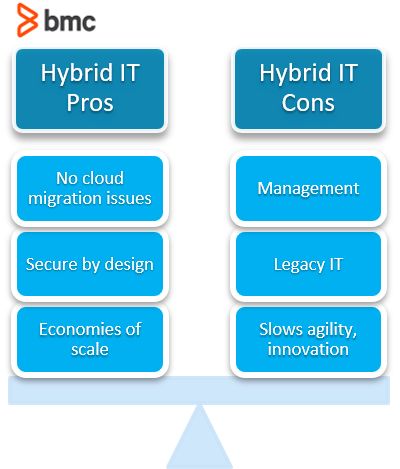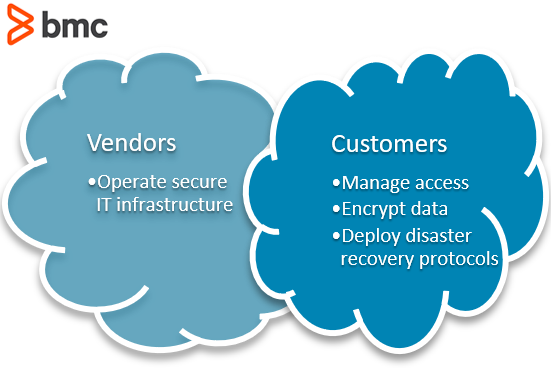You can deliver IT services from the cloud with a strategic advantage that goes beyond cost and scalability advantages. However, many companies still operate and manage services in on-site data centers due to issues such as:
- Security
- Compliance
- Interdependencies with legacy systems
- Cost of migration
As a result, organizations are forced to maintain two isolated IT environments: one in the cloud and one on-premise. This silo—known as the hybrid IT model—offers business-minded advantages. But, the model also causes complexity and limitations in the way apps and services can interact across the two environments.
Chances are you’re already working in a hybrid IT environment—so let’s take a look at the hybrid IT model, including advantages, drawbacks, and tips for managing this hybrid infrastructure.
What is hybrid IT?
Hybrid IT combines on-site data centers with cloud technologies. The goal is not merely to integrate these siloed IT infrastructure environments. It goes beyond that:
Hybrid IT blends cloud architecture flavors—public, private, hybrid—with in-house data centers in order to deliver data workloads, apps, and services across the hybrid infrastructure environments.
This hybrid model allows organizations to manage and govern IT services in a standard way, with a focus on adopting cloud computing as a strategic imperative. The choice of infrastructure resources that power business-sensitive data workloads and apps therefore becomes strategic: you should make this decision based on business agility—not technical or tactical reasons like cost and security.
Hybrid cloud vs hybrid IT
A note on distinction: A hybrid IT model is not the same as a hybrid cloud environment:
- A hybrid cloud environment combines private and public cloud environments.
- A hybrid IT environment allows traditional on-site data center infrastructure to live side-by-side with cloud environments.

Advantages of hybrid IT
Hybrid IT promises several advantages to organizations that need to manage a mix of traditional on-site and hybrid cloud deployments:
Avoids issues with cloud migration
In the short term, you eliminate the complexity of migrating legacy apps to the cloud. The cost and burden of migrating highly dependent legacy workloads is not required, at the cost of innovation and agility that hybrid cloud architecture may promise in the long-term.
A stable IT environment continues to operate as expected, since the complexity of the infrastructure can lead to costly service disruptions. Moreover, limitations in visibility, control, and service levels of cloud systems can make troubleshooting and maintenance challenging for complex legacy IT workloads operating from the cloud.
Security by design
Information security is critical to any business. Cloud migration introduces an additional security risk that legacy apps may not be designed to protect against.
Additionally, security-sensitive data that resides within on-premise data centers is fully controlled and managed by the organizations themselves. Moving workloads to the cloud introduces risks that the vendor must be prepared—and trusted—to protect against, such as:
- External cyber-attacks
- Power outages
- Insider threats
Economies of scale
Migrating all IT workloads to the cloud can be expensive. Especially for organizations looking to expand business services rapidly and to an enterprise-level scale, the total cost of cloud service ownership may be significantly higher than operating their own data center. Instead of engaging third-party cloud vendors, these organizations may operate their data centers in several ways:
- Virtualized
- Cloud-based
- Locally networked
Importantly, organizations can harness a hybrid IT model to establish an optimal mix of subscription, CapEx, and OpEx cost models:
- The subscription and OpEx based pricing models allow organizations to take advantage of economies of scale as they expand their IT service consumption.
- The CapEx model allows them to prepare for the long-term future and achieve low Total Cost of Ownership (TCO) over the long term.
Hybrid IT Challenges
The hybrid IT model means you can operate both the cloud and on-premise infrastructure. It allows organizations to keep traditional in-house IT services running as expected while using cloud-based solutions for services that can be migrated easily.
But it also risks the very foundation of innovation and digital transformation that often require full migration to the cloud in the following ways:
Managing hybrid IT
Cloud computing follows a shared responsibility model, where the vendor is responsible for maintaining infrastructure security while customers assume responsibility to manage information security, access controls, backups, updates, and configurations.

The cloud’s shared responsibility model
The added work may be a burden for organizations operating on limited resources—which may offset the cost value of the cloud, particularly for small- and medium-sized businesses (SMBs).
Legacy IT persists
Hybrid IT allows organizations to operate legacy apps on-premise. Innovation, however, requires modernization of legacy apps, including:
- Platforms
- Functionality
- Infrastructure architecture
Without modernizing, legacy apps continue to bottleneck software delivery performance no matter the availability of a well-integrated and managed cloud architecture. Still, any modernization may still require significant replatforming and reachitecturing of the underlying IT environment.
Traditional IT moves slowly
On the other hand, you can configure cloud services to scale in response to rapid changes in user demands. This means you’re responding in change in two vastly different ways, depending on the environment. Yet, your overall agility is determined only by the performance of dependent services.
If those dependencies are operated on the traditional IT infrastructure, then the overall business agility and performance is compromised.
Securing and optimizing hybrid IT isn’t easy
For many companies, hybrid IT is the reality—even if you didn’t choose it. Still, there are ways to improve how you manage the environment.
The overall cost of managing a Hybrid IT environment may be higher than a Hybrid Cloud architecture model, especially when employees are allowed ungoverned access to cloud-based services. The traditional way of manging IT does not suffice for digital transformation initiatives that require cloud adoption but also retain legacy IT systems and environments as per the Hybrid IT model.
Infrastructure management solutions can only offer limited solutions to these challenges. Reap the most value from your hybrid IT environment. Start by establishing—and enforcing—governance that ensures security and optimizes cost of cloud resources. Then, manage issues like shadow IT that could minimize your value.
Additional resources
For more information, check out these resources:
These postings are my own and do not necessarily represent BMC's position, strategies, or opinion.
See an error or have a suggestion? Please let us know by emailing blogs@bmc.com.





